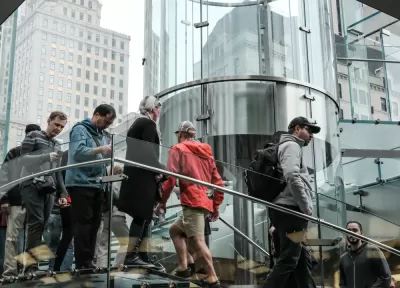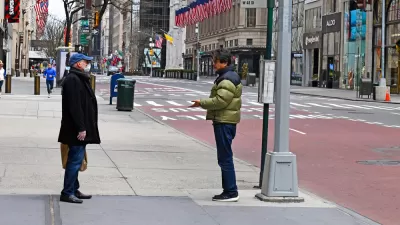Cities around the world are employing vastly different strategies in the effort to get workers back in the office.

Mobility data compiled by Google shows a sharp international divergence in how workers in major financial centers are returning to the office, according to an article by Emily Cadman, Stephan Kahl, Charlotte Ryan, Faris Mokhtar, Nic Querolo, Sarah Holder, Natalie Wong, Steven Arons, Hayley Warren and Sam Dodge. While cities like New York and London have started rebounding, "Singapore and Sydney have had to introduce fresh restrictions as the number of coronavirus cases spikes."
The authors attribute the difference to "vaccination rates and countries’ varying risk appetites." London, New York, and Frankfurt have begun to reopen after vaccines became available, while "cities such as Singapore and Sydney that locked down hard and early—and so got people accustomed to very low levels of infection and risk—have found loosening restrictions tougher as they face further outbreaks."
This hasn't always been the case: by June, Sydney's "[o]ffice occupancy rates had risen to more than 65% of pre-pandemic norms and the state government was poised to launch a voucher program to encourage people back to the city center to eat and drink." But after a massive outbreak of the Delta variant and a months-long lockdown, "the heart of the city is empty." Meanwhile, around 28 percent of the New York region's office workers have returned to work in person and schools fully reopened in September. The article details the trajectory of several other global cities including San Francisco and Frankfurt.
While many cities are experiencing gradual reopenings, "the return to normalcy is still a ways off."
FULL STORY: The March Back to Office Heads in Sharply Different Directions

Planetizen Federal Action Tracker
A weekly monitor of how Trump’s orders and actions are impacting planners and planning in America.

San Francisco's School District Spent $105M To Build Affordable Housing for Teachers — And That's Just the Beginning
SFUSD joins a growing list of school districts using their land holdings to address housing affordability challenges faced by their own employees.

The Tiny, Adorable $7,000 Car Turning Japan Onto EVs
The single seat Mibot charges from a regular plug as quickly as an iPad, and is about half the price of an average EV.

As Trump Phases Out FEMA, Is It Time to Flee the Floodplains?
With less federal funding available for disaster relief efforts, the need to relocate at-risk communities is more urgent than ever.

With Protected Lanes, 460% More People Commute by Bike
For those needing more ammo, more data proving what we already knew is here.

In More Metros Than You’d Think, Suburbs are Now More Expensive Than the City
If you're moving to the burbs to save on square footage, data shows you should think again.
Urban Design for Planners 1: Software Tools
This six-course series explores essential urban design concepts using open source software and equips planners with the tools they need to participate fully in the urban design process.
Planning for Universal Design
Learn the tools for implementing Universal Design in planning regulations.
Smith Gee Studio
City of Charlotte
City of Camden Redevelopment Agency
City of Astoria
Transportation Research & Education Center (TREC) at Portland State University
US High Speed Rail Association
City of Camden Redevelopment Agency
Municipality of Princeton (NJ)





























